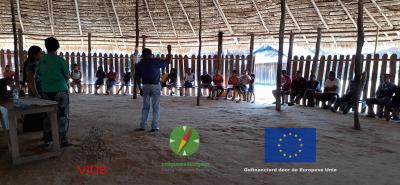Indigenous Navigator Initiative now also in progress in Tepu

Pelelu Tepu. The initial steps of the Indigenous Navigator Initiative process in Pelelu Tepu, abbreviated Tepu, on the Upper Tapanahony River are indicated with marker and flipchart.
This Trio indigenous village is an hour and fifteen minutes south of the capital Paramaribo by plane. Six local women signed up to coordinate the local implementation of the project. After the introduction, the work 'begins' with the distribution of pens and paper. On the first day, issues such as ethics, approach and methods are discussed. The learning environment requires a different approach here in Tepu. What would normally work with city youth needs a different and patient approach here. The material and curricula need to be adapted to the context of this isolated world. Fortunately, Moshesi village chief is also present to help lead the process. The VIDS team, consisting of Carla Madsian and Pauline France, is supported by the Trio translator Maike Jaachpi with the cooperation of the Amazon Conservation Team (ACT).
Three phases (pillars)
Tepu consists of around eighty families. In August and September people are busy intensively on their plots. That is why it is not until the following morning that the local population can be informed of the Indigenous Navigator project through a village meeting. The village chief opens the meeting and makes the introduction. Then the project coordinator, Carla Madsian, talks about the project “Monitoring the rights of indigenous peoples and making the SDGs applicable to indigenous peoples" Maike Jaachpi translates. To monitor (check) the rights of indigenous peoples, data collection is needed and the second phase, the research report, will show to what extent the Sustainable Development Goals (SDGs) are made applicable to the indigenous community. Finally comes the village project in which the locals themselves indicate what they want, from project proposal to project implementation.
Tepu is now starting phase 1 - the research - the ladies on the Indigenous Navigator Team in Tepu have a big task.
The Indigenous Navigator was carried out as a pilot project in six countries in 2014, and then expanded after four years to include four more countries. In both cases, Suriname has continued to participate and support the development of the initiative.
Home to home
The initiative checks the degree of recognition and implementation of indigenous rights. These rights are contained in the
United Nations Declaration on the Rights of Indigenous People (UNDRIP). An eight-page booklet with these rights has been translated into the Trio. The questions for the research are divided into thirteen thematic domains. Each question relates to an Indigenous right. Of the different research methods (5), the first meeting was chosen at the village meeting. Tepu's team will conduct door-to-door visits to gather the data. In this case sixty families have been indetified.
After processing the collected data, VIDS provides support and will compare them with each other. The answers will then be verified at a later date during a village meeting before being published on the Indigenous Navigator website and the Global Portal. Tepu is the fourteenth village where the initiative is being implemented.